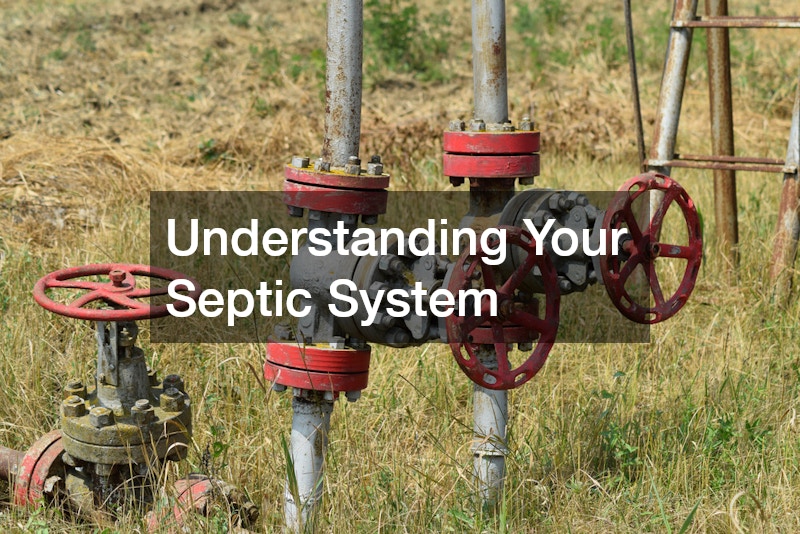When it comes to landscaping around your septic system, there are a few important factors to consider. It’s crucial to understand how your septic system works and how it can impact your landscaping choices. In this article, we will explore the best practices for how to redo landscaping while ensuring the health and functionality of your septic system.
Understanding Your Septic System

Before you start planning your landscaping project, it’s essential to have a good understanding of how your septic system functions. Local septic companies can provide valuable insights into the layout of your system and any potential limitations. Knowing the location of your septic tank and drain field will help you avoid disrupting these crucial components while redoing your landscaping.
Additionally, familiarize yourself with the signs of septic system issues such as local septic tank repair needs. Regular maintenance and inspections can prevent costly repairs down the line and ensure that your landscaping remains in top condition.
When planning to know how to redo landscaping, consider the location of your septic tank and drain field. Avoid planting trees or shrubs with deep roots near these areas to prevent damage to your system. Instead, opt for plants that have shallow root systems and are less likely to interfere with your septic system.
Assessing Your Property
Before starting any landscaping project, it’s crucial to assess your property and take note of any existing issues that may affect your septic system. Local septic tank repair professionals can help identify any potential problems and offer solutions to address them. By addressing these issues before redoing your landscaping, you can ensure the longevity and efficiency of your septic system.
Consider the layout of your property when planning your landscaping project. Local septic pumping companies can provide guidance on the best placement for features such as patios, walkways, and gardens. By working with professionals familiar with septic systems, you can avoid costly mistakes and create a beautiful and functional landscape that complements your property.
When redesigning your landscaping, keep in mind the need for adequate drainage around your septic system. Proper drainage will prevent water from pooling near your septic tank or drain field, which can lead to malfunctions and costly repairs. Consult with local septic pumping experts for advice on how to redo landscaping and determine the best drainage solutions for your property.
Local Regulations and Guidelines
Before you begin your landscaping project, be sure to familiarize yourself with local regulations and guidelines regarding septic systems. Local septic pumping companies can provide information on any restrictions or requirements that may impact your landscaping plans. By adhering to these regulations, you can ensure that your landscaping project is environmentally friendly and complies with local laws.
When redoing your landscaping, it’s essential to work with reputable septic companies for services such as septic system replacements. These professionals have the expertise and equipment necessary to complete complex projects while minimizing disruption to your property. By partnering with experienced septic professionals, you can ensure that your landscaping project is completed safely and efficiently.
Regular maintenance is key to the longevity of your septic system. Contact a septic cleaning company to schedule routine cleanings and inspections to keep your system running smoothly. By knowing how to redo landscaping and staying on top of maintenance tasks, you can prevent costly repairs and ensure the health and functionality of your septic system. Additionally, educate yourself on any seasonal maintenance needs, such as checking for system blockages or ensuring proper drainage, to further enhance your system’s efficiency and lifespan. This proactive approach will not only protect your investment but also contribute to a healthier environment.
Choosing the Right Plants

When planning your landscaping project, selecting the right plants is crucial for the health of your septic system. Local septic pumping experts can recommend plants that are suitable for the proximity to your system. By choosing plants that are compatible with your septic system, you can enhance the beauty of your landscape without compromising the functionality of your system.
Consider the maintenance requirements of the plants you choose for your landscaping. Low-maintenance plants are ideal for busy homeowners who may not have the time to dedicate to extensive upkeep. By selecting plants that thrive in your climate and soil conditions, you can create a vibrant landscape that enhances your property’s curb appeal.
Consult with a landscape architect when designing your landscaping project. These professionals can offer valuable insights on plant selection, layout, and design elements that will complement your septic system. By knowing how to redo landscaping and working with a landscape architect, you can create a cohesive and visually appealing landscape that enhances your property’s overall aesthetic. Additionally, prioritize native plants, as they often require less water and care while providing essential habitat for local wildlife, further enriching your outdoor space. This eco-friendly approach not only benefits your landscape but also supports the health of your septic system.
Creating a Landscape Design
When redesigning your landscaping, it’s essential to create a cohesive landscape design that takes your septic system into account. Local septic tank repair professionals can help you design a layout that minimizes the risk of damage to your system. By incorporating your septic system into your landscape design, you can create a functional and visually appealing outdoor space.
Consider the flow of traffic in your landscape design to ensure that your septic system remains easily accessible for maintenance and repairs. Pathways and walkways should be strategically placed to provide convenient access to your septic tank and drain field. By designing a landscape that is both beautiful and functional, you can enjoy your outdoor space for years to come.
Incorporate a variety of plant textures, colors, and heights into your landscape design to create visual interest. By mixing different plant species, you can create a dynamic and vibrant landscape that enhances the overall look of your property. Consider creating focal points such as garden beds or seating areas to draw the eye and create a sense of balance in your landscaping. Additionally, ensure that the selected plants are suitable for the specific soil and moisture conditions around your septic system to promote healthy growth and prevent any adverse effects on the system. By knowing how to redo landscaping, this thoughtful approach will yield a thriving and harmonious outdoor environment.
Avoiding Compaction
When redoing your landscaping, it’s important to avoid compacting the soil near your septic system. Compacted soil can impede the flow of water and oxygen to your system, leading to potential issues. Local septic system replacements experts can advise on ways to prevent soil compaction and maintain the health of your septic system.
Avoid heavy machinery and equipment near your septic system when working on your landscaping project. Heavy equipment can compact the soil and disrupt the delicate balance of your septic system. Opt for hand tools and lightweight equipment whenever possible to minimize the impact on your soil and system.
Consider installing raised garden beds or planting containers near your septic system to prevent soil compaction. Raised beds provide a barrier between your landscaping and your septic system, reducing the risk of damage to your system. By knowing how to redo landscaping and incorporating raised beds into your landscaping design, you can create a visually appealing and functional space that protects your septic system. Additionally, incorporating ground covers can help stabilize the soil and reduce erosion, further safeguarding your septic system’s integrity while enhancing your landscape’s aesthetic appeal.
Drainage Considerations

Proper drainage is essential for the health and functionality of your septic system. When planning your landscaping project, consider the natural slope of your property and how water flows. Local septic companies can assist in identifying areas that may require additional drainage solutions to prevent water pooling near your system.
Install gutters and downspouts to direct rainwater away from your septic system. By diverting water away from your drain field, you can prevent oversaturation and maintain a healthy balance in your system. Consider adding French drains or dry wells to further manage excess water and protect your septic system.
Landscaping features such as swales and berms can also help redirect water away from your septic system. By knowing how to redo landscaping and strategically placing these features, you can create natural drainage pathways that prevent water from collecting near your drain field. Consult with septic system experts to determine the best drainage solutions for your property. Additionally, regularly inspect and maintain these drainage systems to ensure they function correctly, helping to prolong the life of your septic system and enhance the overall health of your landscape.
Using Mulch Effectively
Mulch is a versatile landscaping material that can provide numerous benefits for your septic system. When redoing your landscaping, consider using mulch around your plants to retain moisture and suppress weeds. Local septic cleaning companies can recommend the best type of mulch for your specific plants and soil conditions.
Apply a layer of organic mulch around your plants to improve soil health and provide nutrients for your landscaping. Organic mulches such as wood chips or compost break down over time, enriching the soil and promoting plant growth. By using mulch effectively, you can create a healthy and thriving landscape that enhances the beauty of your property.
Avoid using heavy layers of mulch near your septic system to prevent soil compaction. Excessive mulch can trap moisture near your drain field, leading to potential issues with your septic system. Consult with a landscaping professional to determine the right amount of mulch to use in your landscaping project. Additionally, consider incorporating decorative stones or gravel as alternatives to mulch in certain areas, providing aesthetic appeal while maintaining proper drainage around your septic system.
Installing Edging and Pathways
Edging and pathways are essential elements of a well-designed landscape that can enhance the functionality of your outdoor space. When planning your landscaping project, consider installing edging around garden beds and walkways to create defined borders. Local plant nurseries can provide a variety of edging materials that complement your overall design.
Choose durable materials such as stone or brick for your edging to withstand foot traffic and weather conditions. Edging can help prevent erosion and soil displacement, protecting the health of your plants and your septic system. By installing quality edging, you can create a polished and cohesive landscape that adds structure and visual appeal to your property.
Create pathways that connect different areas of your landscape to encourage exploration and enjoyment of your outdoor space. Pathways should be wide enough to accommodate foot traffic and provide easy access to your septic system for maintenance. By knowing how to redo landscaping and incorporating well-designed pathways into your landscaping, you can create a cohesive and functional outdoor environment.
Incorporating Hardscaping

Hardscaping features such as patios, decks, and retaining walls can add value and functionality to your landscape design. When redoing your landscaping, consider incorporating hardscaping elements that complement your septic system and overall property layout. Consult with a landscape architect to design hardscaping features that enhance the beauty and usability of your outdoor space.
Choose materials for your hardscaping that are durable and low-maintenance to ensure longevity and functionality. Local landscape architects can recommend materials such as pavers, concrete, or natural stone that are suitable for your climate and soil conditions. By knowing how to redo landscaping and selecting quality materials, you can create hardscaping features that withstand the test of time and enhance the aesthetics of your property.
Integrate hardscaping elements such as seating areas or fire pits into your landscape design to create inviting outdoor spaces for relaxation and entertainment. By incorporating hardscaping features that provide additional seating and gathering areas, you can maximize the usability of your landscape. Additionally, consider visiting a local plant nursery to choose complementary plants that will thrive alongside your hardscaping. Work with a landscape architect to create a cohesive and harmonious outdoor environment that reflects your style and enhances your property.
Knowing how to redo landscaping around your septic system requires careful consideration and planning to ensure the health and functionality of your system. By understanding how your septic system works and working with local septic professionals, you can create a beautiful and functional landscape that complements your property. Remember to follow local regulations and guidelines, choose the right plants for your septic system, and incorporate proper drainage solutions into your landscape design. With proper maintenance and care, you can enjoy a vibrant and sustainable landscape that enhances your property for years to come.

